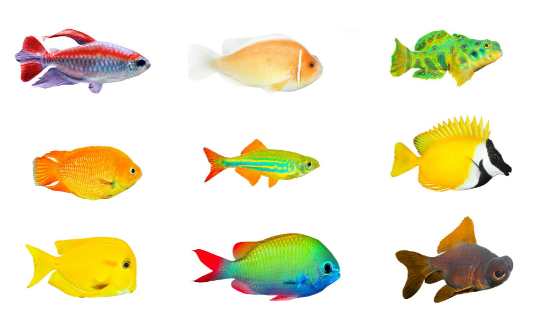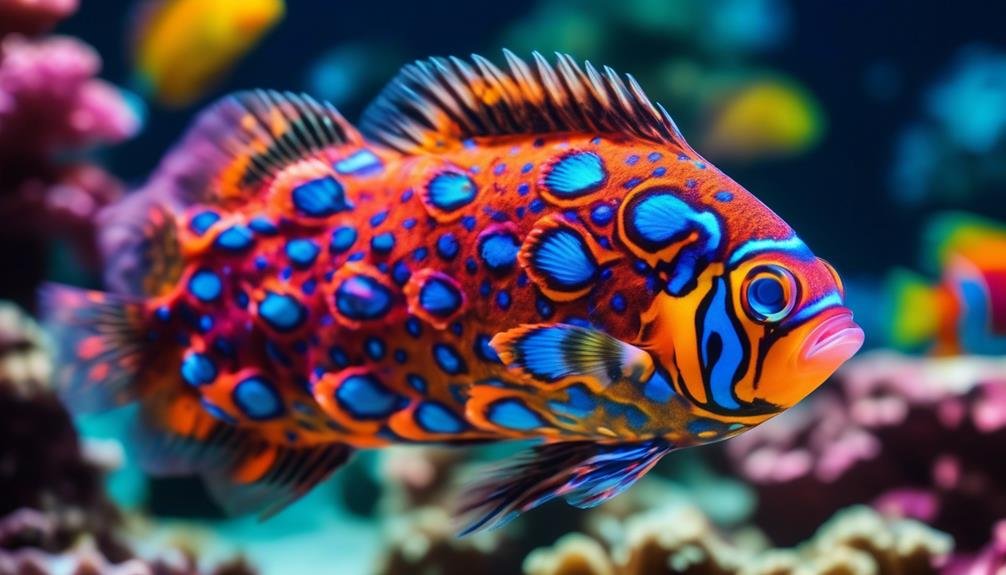
By pure coincidence, you stumble upon a mesmerizing underwater world filled with vibrant colors and feisty energy.
The inhabitants that catch your eye are the Dottyback fish, a true aquatic marvel. These small saltwater wonders come in over 100 distinct species, each boasting a stunning array of colors that will leave you in awe.
But their allure goes beyond their appearance. With their hardy nature and intelligence, Dottybacks have become a favorite among aquarists.
However, there’s more to learn about these fascinating creatures, from their behavior and origins to their unique breeding habits.
So, why not dive deeper into the captivating world of Dottyback fish and uncover the secrets that await?
Key Takeaways
- Dottyback fish are small saltwater fish known for their vibrant colors and popularity among aquarists.
- They are hardy and intelligent, but can be aggressive and territorial, especially towards fish of their own species.
- Dottybacks prefer aquariums with plenty of hiding places and dimly lit environments.
- They have a carnivorous diet and can be fed live foods such as shrimp and plankton.
Dottyback Fish: An Overview
Are you curious about the vibrant and feisty Dottyback fish? These small saltwater fish belong to a family with over 100 distinct species, and they come in a stunning array of colors, including red, yellow, orange, blue, purple, grey, black, and white. They’re hardy, intelligent, and popular among aquarists. Most species don’t grow larger than 4 inches in length, making them suitable for smaller tanks.
However, it’s important to note that Dottybacks can be community aggressive and highly territorial. They’ve the capability to harass and attack fish up to twice their size. When it comes to care, it’s advisable to house them with larger, mildly aggressive tank mates and provide plenty of caves and crevices for hiding.
Their carnivorous diet consists of live foods such as mysis shrimp, brine shrimp, and plankton, but they’ll also feed on live rock when available.
Breeding Dottybacks is fairly easy in a home aquarium environment, as long as you provide the right conditions and adequate tank space. The male performs a mating dance outside the cave to entice the female, who then lays up to 1000 eggs inside. The male diligently guards the eggs until the fry hatch.
It’s interesting to note that all Dottybacks are born hermaphrodites and can adapt both male and female reproductive systems.
Dottyback Fish: Vibrant Colors
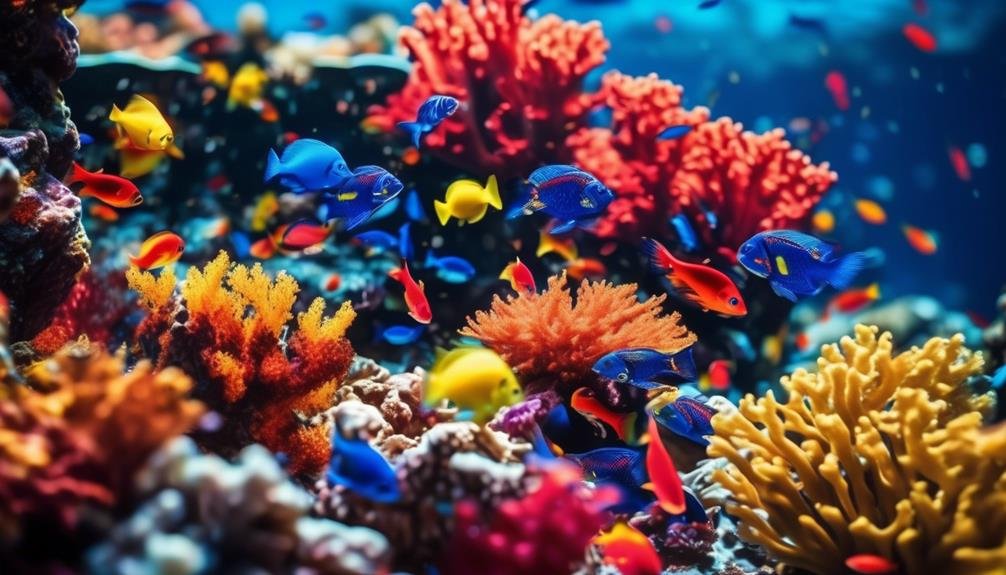
If you’re captivated by the stunning Dottyback fish, you’ll be amazed at their vibrant colors. These small saltwater fish come in a variety of shades, ranging from red, yellow, and orange to blue, purple, and even black and white. Their colorful appearance makes them a popular choice for aquarium enthusiasts. To give you a better idea of the range of colors you can find in Dottybacks, here’s a table showcasing some of the most common hues:
| Color | Description |
|---|---|
| Red | Bright and eye-catching |
| Yellow | Sunny and cheerful |
| Orange | Warm and vibrant |
| Blue | Cool and serene |
With their vivid hues, Dottybacks add a burst of color to any aquarium, creating a visually stunning underwater display.
Dottyback Fish: Popular Aquarist Choice
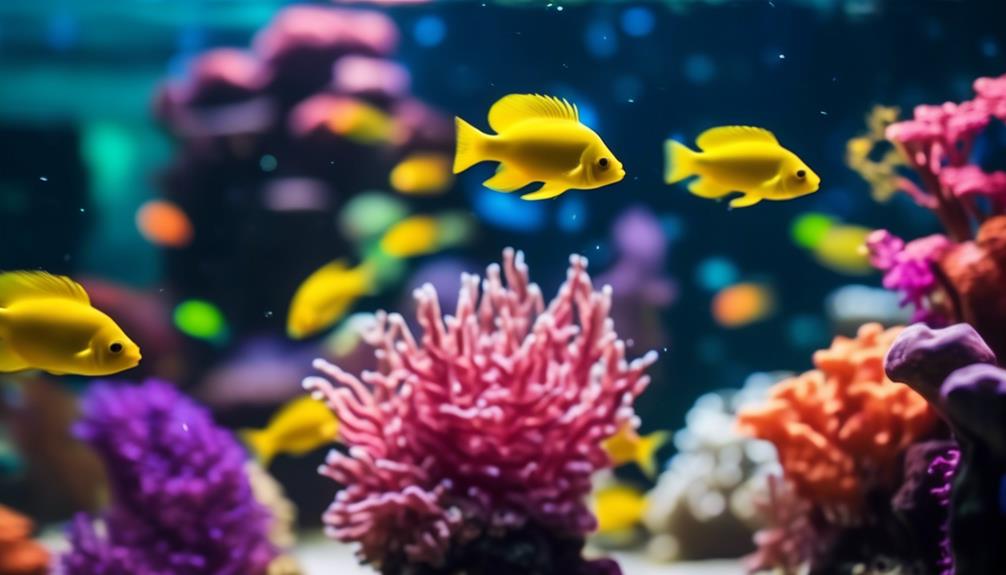
Aquarists widely favor Dottyback fish for their vibrant colors and feisty temperament. These small saltwater fish, with over 100 distinct species, add a stunning visual appeal to any aquarium. Their shades of red, yellow, orange, blue, purple, grey, black, and white make them a popular choice among hobbyists.
Not only are Dottybacks visually appealing, but they also possess a feisty temperament that adds excitement to the aquarium. These fish are highly territorial and capable of harassing and attacking fish up to twice their size. It’s advisable to house them with larger, mildly aggressive tank mates.
While they may be challenging to introduce new fish to the aquarium, their intelligence and hardiness make them a rewarding choice for experienced aquarists.
Dottyback Fish: Size and Availability
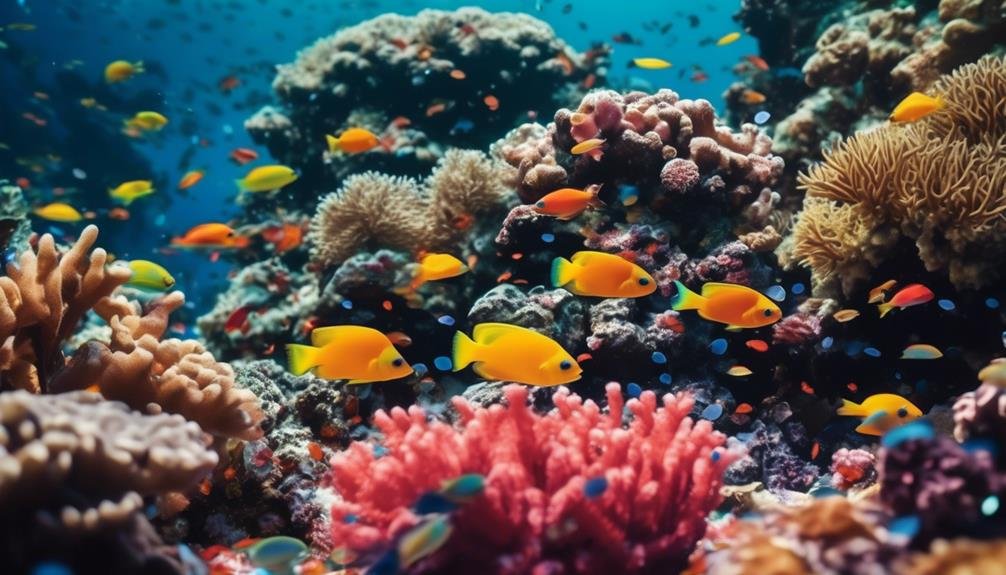
Dottyback fish come in a variety of sizes and are readily available in the aquarium trade. Most species don’t exceed 4 inches in length, making them suitable for smaller tanks. However, it’s important to note that some species can grow slightly larger, reaching up to 6 inches.
The availability of dottybacks in the aquarium trade is quite good, with tank-raised specimens being commonly found. This is beneficial for hobbyists as it ensures a healthier and more adaptable fish. Additionally, the popularity of dottybacks among aquarists has led to a wide range of color variations being bred, further increasing their availability.
Whether you’re a beginner or an experienced aquarist, finding and accommodating a dottyback fish in your aquarium should be a relatively easy task.
Dottyback Fish: Behavior and Temperament
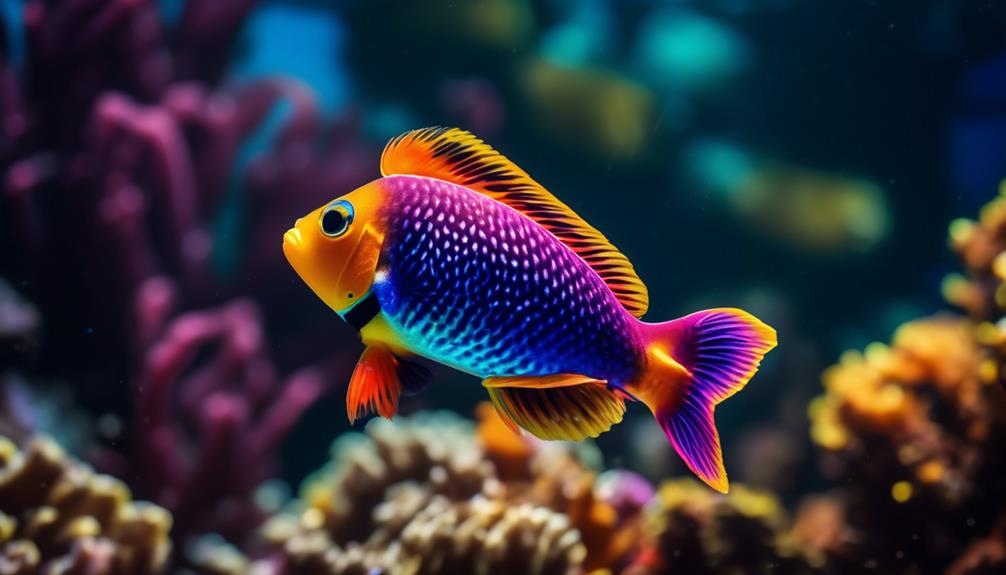
Now let’s explore the fascinating behavior and temperament of these vibrant dottyback fish.
- Origins: Dottybacks come from tropical and sub-tropical regions of the Indo-Pacific Ocean.
- Temperament: They’re community aggressive, highly territorial, and capable of harassing and attacking fish up to twice their size. It’s advisable to house them with larger, mildly aggressive tank mates.
- Introducing new fish: Problems can arise when introducing new fish to the aquarium, as dottybacks can be extremely aggressive towards fish of their own species, especially in smaller aquariums.
- Habitat preference: They prefer aquariums with plenty of caves and crevices to hide in and dimly lit environments.
- Feeding: Dottybacks have a carnivorous diet and can be fed live foods such as mysis shrimp, brine shrimp, and plankton. They’ll also feed on live rock when available.
- Breeding: Dottybacks are fairly easy to breed in a home aquarium environment with the right conditions and adequate tank space. The male performs a mating dance outside the cave to entice the female, who then lays up to 1000 eggs inside. The male guards the eggs until the fry hatch. It’s interesting to note that all dottybacks are born hermaphrodites and can adapt both male and female reproductive systems.
Dottyback Fish: Tank Mates and Introductions
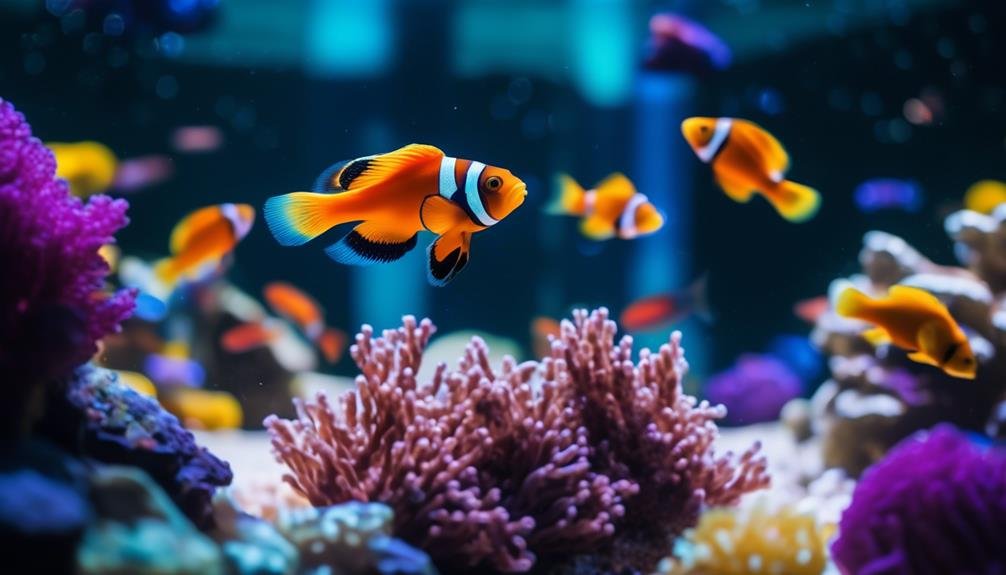
When introducing new fish to an aquarium containing dottybacks, it’s important to be cautious due to their aggressive nature, especially towards fish of their own species. Dottybacks are highly territorial and can harass and attack fish up to twice their size. In smaller aquariums, problems can arise when introducing new fish, as dottybacks can become extremely aggressive towards fish of the same species.
It’s advisable to house them with larger, mildly aggressive tank mates to minimize conflicts. Additionally, providing plenty of caves and crevices for hiding and creating a dimly lit environment can help reduce aggression.
Feeding dottybacks a carnivorous diet, including live foods such as mysis shrimp, brine shrimp, and plankton, is recommended. They’ll also feed on live rock when available.
Dottyback Fish: Territorial Nature
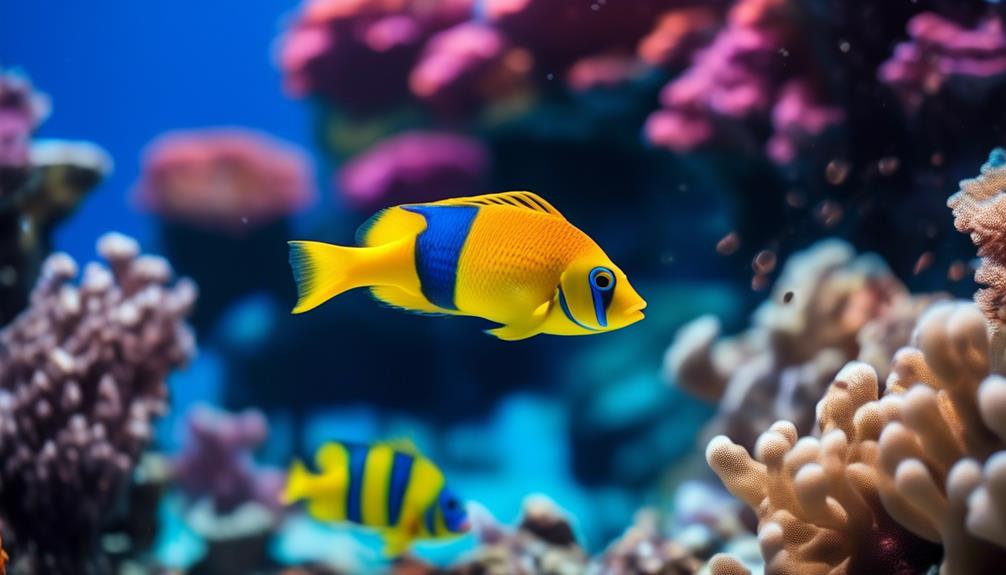
As you introduce new fish to an aquarium housing dottybacks, it’s crucial to be aware of their aggressive nature, particularly towards fish of their own species. Here are some key points to keep in mind:
- Dottybacks are highly territorial and can become aggressive towards other fish, especially in smaller aquariums.
- They prefer aquariums with plenty of caves and crevices to hide in and dimly lit environments.
- It’s advisable to house dottybacks with larger, mildly aggressive tank mates to minimize conflicts.
Understanding the territorial nature of dottybacks is essential for maintaining a harmonious aquarium environment. By providing ample hiding spaces and carefully selecting tank mates, you can help ensure the well-being of these colorful and feisty aquatic marvels.
Dottyback Fish: Ideal Aquarium Conditions
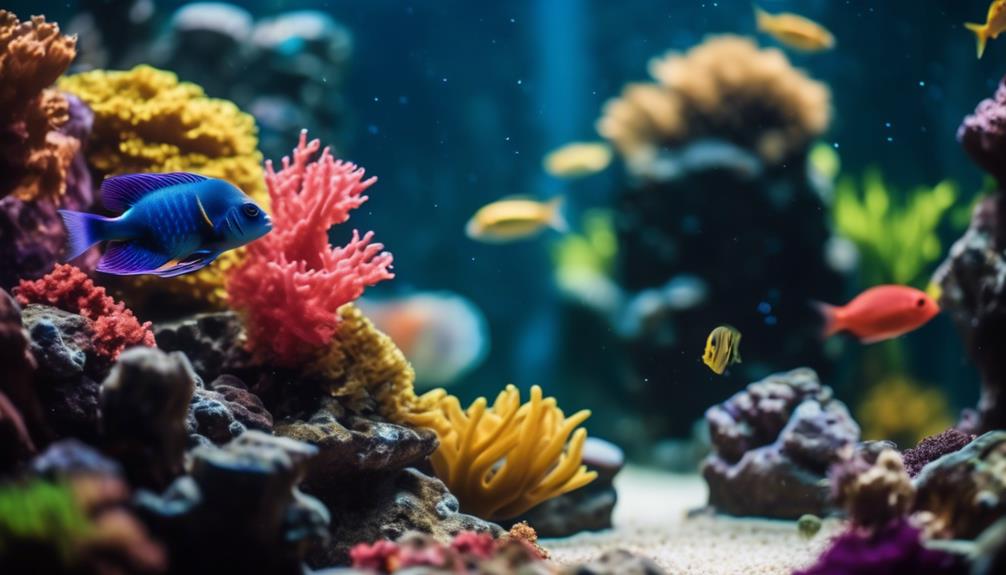
To provide the best environment for dottyback fish in your aquarium, it is important to create ideal conditions that cater to their specific needs. Dottybacks are highly territorial and prefer aquariums with plenty of caves and crevices to hide in and dimly lit environments. They are also carnivorous and should be fed a diet that includes live foods such as mysis shrimp, brine shrimp, and plankton. Additionally, it is advisable to house dottybacks with larger, mildly aggressive tank mates to avoid conflicts. Introducing new fish to the aquarium can be problematic, as dottybacks are extremely aggressive towards fish of their own species, especially in smaller tanks. By providing these ideal conditions, you can ensure that your dottyback fish thrive and display their vibrant colors and feisty nature.
| Ideal Aquarium Conditions for Dottyback Fish |
|---|
| – Plenty of caves and crevices to hide in |
| – Dimly lit environments |
| – Carnivorous diet, including live foods |
| – House with larger, mildly aggressive tank mates |
| – Avoid introducing new fish to the aquarium |
Dottyback Fish: Feeding Habits
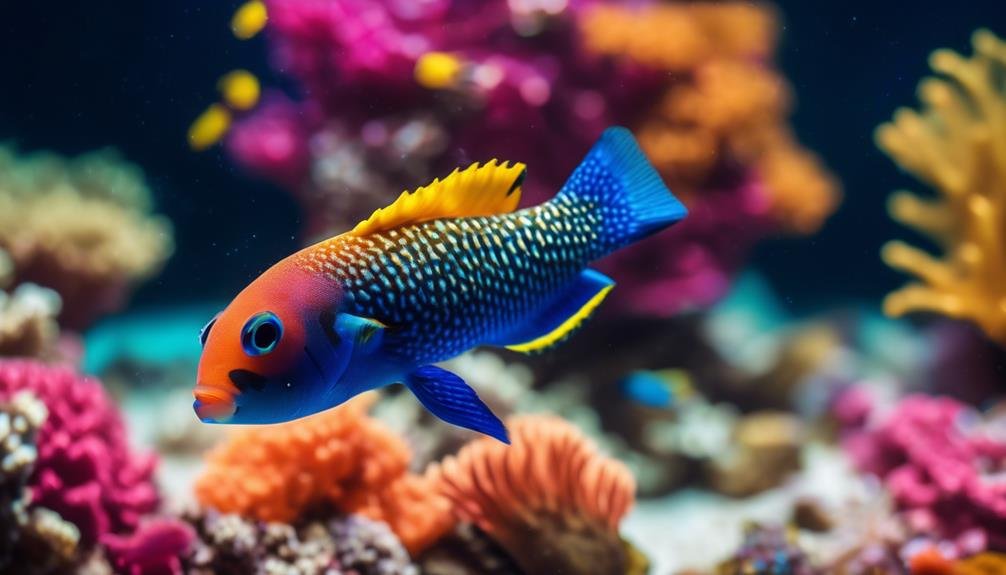
Dottyback fish have a carnivorous diet and prefer live foods such as mysis shrimp, brine shrimp, and plankton. To paint a picture of their feeding habits, here are three key points:
- Dottybacks are voracious eaters, constantly on the lookout for their next meal.
- They use their sharp teeth and strong jaws to snatch live prey from the water column.
- Their hunting style involves stalking their prey and launching swift attacks to capture it.
In the wild, dottybacks feed on small crustaceans and zooplankton. In aquariums, it’s important to provide them with a varied diet to ensure their nutritional needs are met. Live foods like mysis shrimp and brine shrimp are excellent options, as they mimic their natural diet. Additionally, offering plankton can provide them with a well-rounded and nutritious diet.
Dottyback Fish: Breeding Process
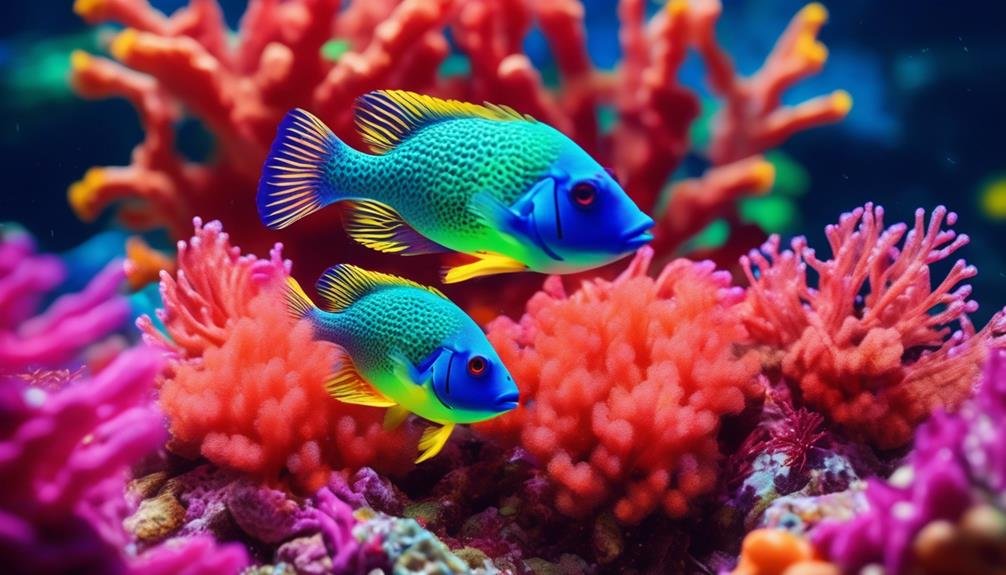
After learning about the feeding habits of dottyback fish, let’s now explore their fascinating breeding process.
Breeding dottybacks in a home aquarium is fairly easy, as long as you provide the right conditions and enough tank space. The male dottyback performs a mating dance outside the cave to entice the female. Once the female is ready, she lays up to 1000 eggs inside the cave.
The male then takes on the responsibility of guarding the eggs until they hatch. It’s interesting to note that all dottybacks are born hermaphrodites, meaning they’ve both male and female reproductive systems. This adaptability allows them to switch roles if necessary.
Dottyback Fish: Hermaphroditism
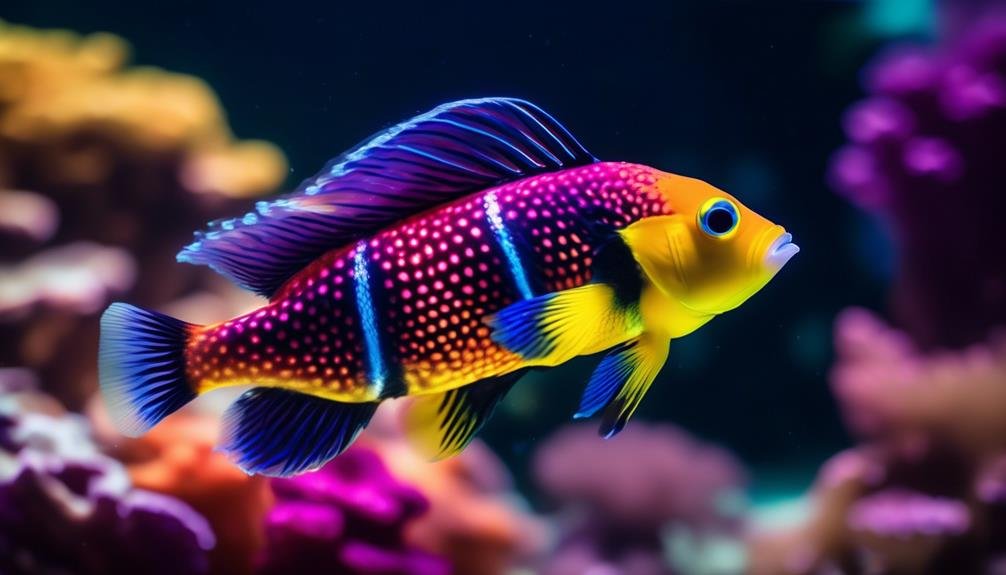
The remarkable trait of hermaphroditism sets dottyback fish apart in the world of aquatic marvels. These vibrant and feisty fish possess the unique ability to adapt both male and female reproductive systems. Here is a closer look at this fascinating feature:
- Natural Adaptation:
- Dottybacks are born hermaphrodites, allowing them to switch genders as needed.
- They can function as males when courting a female and then transition to females when ready to lay eggs.
- This flexibility ensures successful reproduction even in situations where suitable mates are scarce.
- Reproductive Behavior:
- Male dottybacks perform elaborate mating dances to attract females.
- After successful courtship, the female lays a large number of eggs inside a cave.
- The male diligently guards the eggs until they hatch, providing parental care.
- Survival Advantage:
- Hermaphroditism increases the chances of finding a compatible partner, as any dottyback can potentially fulfill the role of either gender.
- This adaptability enhances their reproductive success and contributes to the survival of the species.
Dottyback Fish: History and Origins
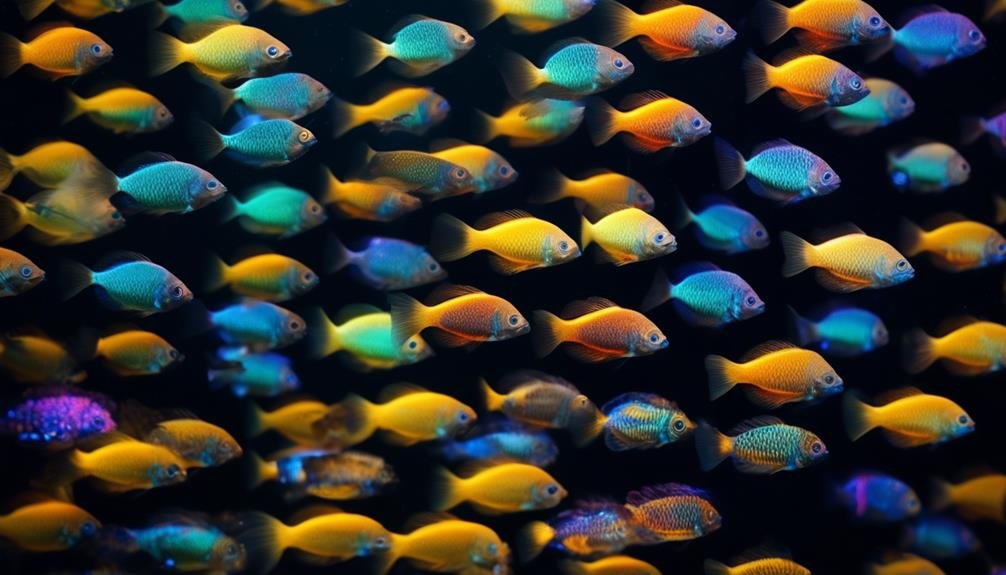
Originating from the tropical and sub-tropical regions of the Indo-Pacific Ocean, the history and origins of Dottyback fish are both fascinating and diverse. These small saltwater fish have captured the attention of aquarists with their vibrant colors and feisty behavior. With over 100 distinct species, Dottybacks come in shades of red, yellow, orange, blue, purple, grey, black, and white. They are hardy and intelligent, making them popular choices for aquariums. Most species do not grow larger than 4 inches in length, and tank-raised specimens are readily available in the aquarium trade.
| Dottyback Fish Breed Information | |
|---|---|
| Small saltwater fish family with over 100 distinct species | |
| Vibrantly colored in shades of red, yellow, orange, blue, purple, grey, black, and white | |
| Hardy, intelligent, and popular among aquarists | |
| Most species do not grow larger than 4 inches in length | |
| Tank raised specimens are readily available in the aquarium trade |
Dottybacks originate from the tropical and sub-tropical regions of the Indo-Pacific Ocean. They are known for their community aggressive behavior, being highly territorial and capable of harassing and attacking fish up to twice their size. It is advisable to house them with larger, mildly aggressive tank mates to prevent conflicts. Problems can arise when introducing new fish to the aquarium, and Dottybacks are extremely aggressive towards fish of their own species, especially in smaller aquariums. They prefer aquariums with plenty of caves and crevices to hide in and dimly lit environments. Dottybacks have a carnivorous diet and can be fed live foods such as mysis shrimp, brine shrimp, and plankton. They will also feed on live rock when available.
Breeding Dottybacks can be fairly easy in a home aquarium environment with the right conditions and adequate tank space. The male performs a mating dance outside the cave to entice the female, who then lays up to 1000 eggs inside the cave. The male guards the eggs until they hatch into fry. It is interesting to note that all Dottybacks are born hermaphrodites and can adapt both male and female reproductive systems.
Dottyback Fish: Recognition in the Aquarium Trade
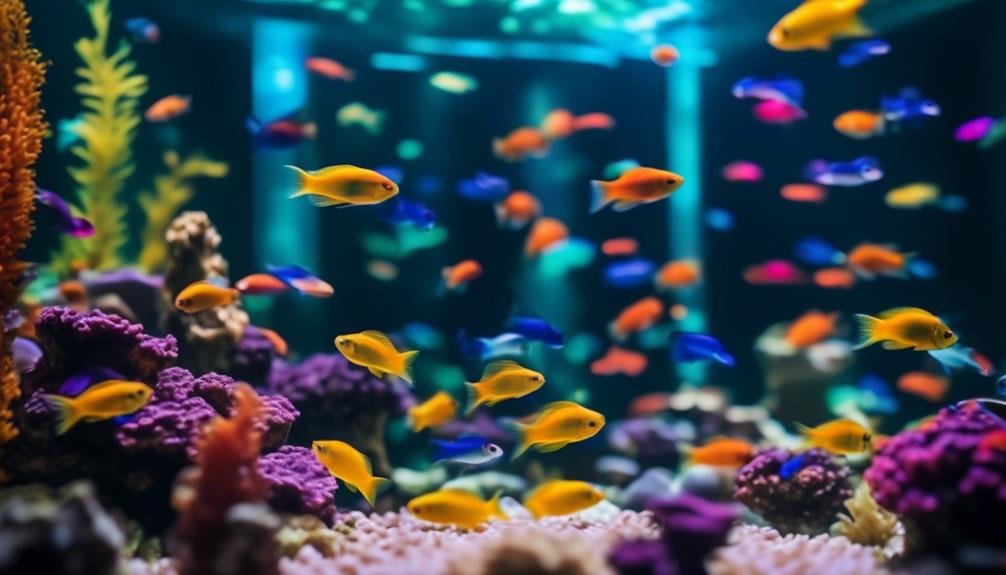
To understand the recognition of Dottyback fish in the aquarium trade, let’s explore their popularity and demand among aquarists.
- They’re highly sought after for their vibrant colors, which include shades of red, yellow, orange, blue, purple, grey, black, and white.
- Their small size, typically not exceeding 4 inches in length, makes them suitable for a variety of tank sizes.
- Tank-raised specimens are readily available in the aquarium trade, ensuring a constant supply for enthusiasts.
These factors contribute to the widespread recognition of Dottyback fish in the aquarium trade.
Their eye-catching colors, combined with their manageable size and availability, make them a popular choice among aquarists. Whether you’re a seasoned hobbyist or a beginner, these feisty and colorful aquatic marvels are sure to add a touch of vibrancy to your underwater world.
Dottyback Fish: Interesting Facts
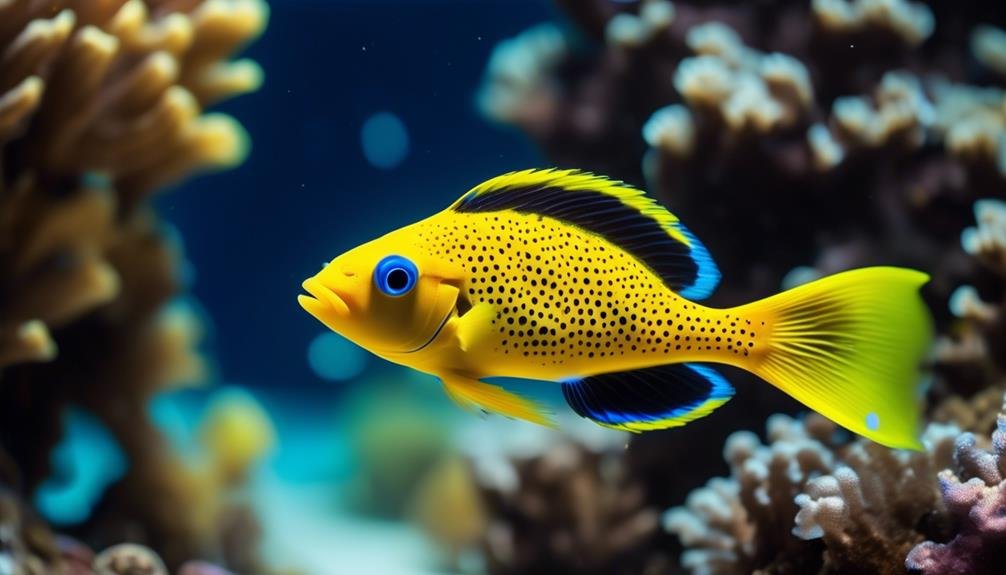
Did you know that Dottyback fish have the ability to change their sex? It’s true! These fascinating creatures are born hermaphrodites, meaning they possess both male and female reproductive systems. This unique adaptation allows them to change their sex as needed.
When a dominant male is absent, the largest female in a group will undergo a sex change to become the new male. This ensures the continuation of the species.
Dottyback fish are also known for their vibrant colors, ranging from red and yellow to blue and purple. They’re highly territorial and aggressive, often harassing and attacking fish twice their size.
To keep them happy, it’s best to provide plenty of hiding spots and a carnivorous diet consisting of live foods like shrimp and plankton.
Dottyback Fish: Care Tips and Conclusion
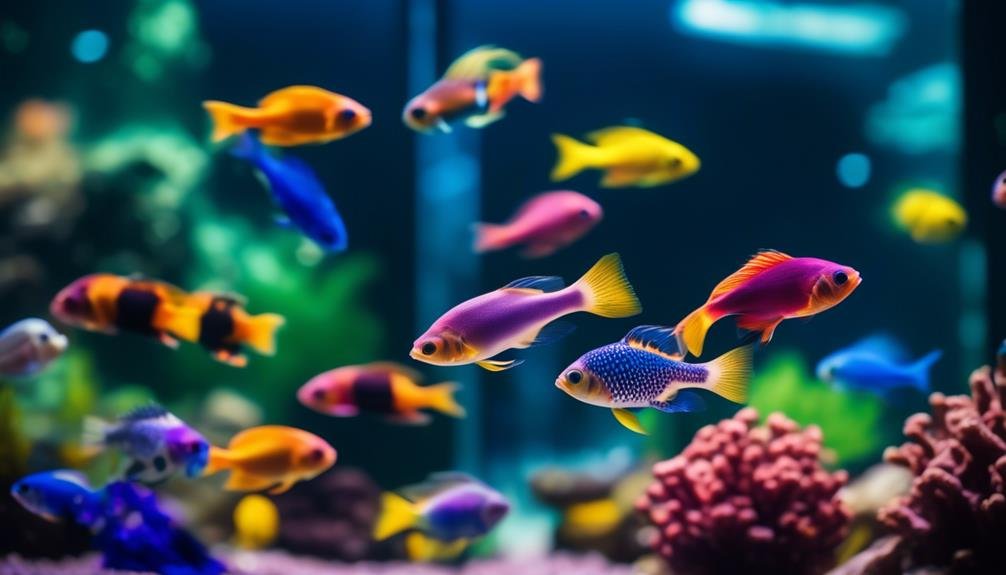
Now that you have learned about the interesting facts of Dottyback fish, let’s explore some care tips and conclude our discussion about these fascinating aquatic marvels.
To ensure the well-being of your Dottyback fish, here are some care tips to keep in mind:
- Tank Setup:
- Provide plenty of hiding spots such as caves and crevices to make your Dottyback feel secure.
- Dimly lit environments are preferable as these fish come from tropical and sub-tropical regions.
- Use live rock to create a natural habitat and help meet their feeding needs.
- Tank Mates:
- Dottybacks are community aggressive and highly territorial, so it’s advisable to house them with larger, mildly aggressive tank mates.
- Problems can arise when introducing new fish to the aquarium, so be cautious and monitor their behavior closely.
- Feeding:
- Dottybacks are carnivorous and enjoy a diet of live foods like mysis shrimp, brine shrimp, and plankton.
- They’ll also feed on live rock when available.
Frequently Asked Questions
Can Dottyback Fish Change Their Colors Over Time?
Yes, dottyback fish can change their colors over time. They have the ability to adjust their coloration based on their mood, environment, and social interactions. This allows them to blend in or stand out as needed.
What Is the Average Lifespan of a Dottyback Fish?
The average lifespan of a dottyback fish is around 5 to 8 years. They can live longer with proper care and a healthy environment.
Are There Any Specific Tank Decorations That Dottyback Fish Prefer?
Dottyback fish prefer tank decorations that provide plenty of caves and crevices to hide in. They also prefer dimly lit environments. These features mimic their natural habitat and help them feel secure in the aquarium.
How Often Should Dottyback Fish Be Fed?
You should feed dottyback fish once or twice a day, depending on their size and appetite. Offer them a varied diet of live or frozen foods like mysis shrimp, brine shrimp, and plankton.
Are There Any Specific Health Issues or Diseases That Dottyback Fish Are Prone To?
Dottyback fish are prone to certain health issues and diseases. It’s important to monitor for signs of parasitic infections, bacterial infections, and marine velvet disease. Regular water testing and proper tank maintenance can help prevent these issues.
Can Platies and Dottyback Fish Coexist in the Same Aquarium?
Yes, colorful playful platies freshwater fish can coexist with dottyback fish in the same aquarium. However, it is important to consider the temperament and size of the dottyback to ensure compatibility. With proper tank size and decorations, these vibrant fish can create a harmonious underwater environment.
Conclusion
In conclusion, Dottyback fish are a stunning and lively addition to any saltwater aquarium. With their vibrant colors and feisty personalities, they bring a sense of energy and life to the tank.
However, it’s important to remember their territorial nature and choose suitable tank mates. With proper care and understanding of their behavior, Dottybacks can thrive and create a harmonious environment for all.
So why wait? Dive into the captivating world of Dottyback fish and enjoy their beauty and charm.




